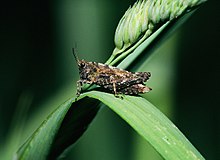Loading AI tools
Family of grasshoppers From Wikipedia, the free encyclopedia
Tetrigidae[1] is an ancient family in the order Orthoptera,[2] which also includes similar families such as crickets, grasshoppers, and their allies. Species within the Tetrigidae are variously called groundhoppers,[3] pygmy grasshoppers,[4] pygmy devils[5] or (mostly historical) "grouse locusts".[6]
| Tetrigidae | |
|---|---|
 | |
| Tetrix species | |
| Scientific classification | |
| Domain: | Eukaryota |
| Kingdom: | Animalia |
| Phylum: | Arthropoda |
| Class: | Insecta |
| Order: | Orthoptera |
| Suborder: | Caelifera |
| Superfamily: | Tetrigoidea |
| Family: | Tetrigidae Rambur, 1838 |
| Subfamilies | |
| |


Tetrigidae are typically less than 20 mm in length and are recognizable by a long pronotum. This pronotum extends over the length of the abdomen, sometimes to the tip of the wings, and ends in a point.[4] In other Orthoptera, the pronotum is short and covers neither the abdomen nor the wings. Tetrigidae are generally cryptic in coloration.[7] Some species have enlarged pronota that mimic leaves, stones or twigs.[8][9] Other characteristics pygmy grasshoppers exhibit in comparison to other Orthoptera families are the lack of an arolium between the claws, the first thoracic sternite being modified into collar-like structure called sternomentum, a tarsal formula of 2-2-3, scaly fore -wings, and developed hindwings.[10]
In temperate regions, Tetrigidae are generally found along streams and ponds, where they feed on algae and diatoms.[11] The North American species Paratettix aztecus and Paratettix mexicanus, for example, depend on aquatic primary production for between 80% and 100% of their diet.[12] Riparian species are capable of swimming on the surface of the water, and readily leap into the water when alarmed[9] Some species in the tribe Scelimenini are fully aquatic and capable of swimming underwater.[10][11]
The highest biodiversity of Tetrigidae is found in tropical forests.[10] Some tropical species are arboreal and live among mosses and lichens in tree buttresses or in the canopy,[11] while others live on the forest floor.[7]
Like other Orthoptera, Tetrigidae have a hemimetabolous development, in which eggs hatch into nymphs. Unlike other temperate Orthoptera, however, temperate Tetrigidae generally overwinter as adults.[4]
Some subfamilies within the Tetrigidae, such as the Batrachideinae, are sometimes elevated to family rank besides the Tetrigidae.
Arulenus miae is a pygmy grasshopper species from the tropical mountainous rainforests of the Philippines. The species was firstly discovered in Facebook post.[5]

Origin of the name of the family is not completely clear as there are different sources on its etymology. The name may be derived from Latin tetricus or taetricus, meaning harsh, sour, severe.[13] The name may also originate from the earlier name 'Tettigidae', based on Tettix (synonym of Tetrix), which was preoccupied by Tettigidae (synonym of Cicadidae).[14] Because of the preoccupation by the cicadas' family name, the second 't' in 'tt' was changed into 'r', resulting in the word Tetrigidae.
Approximately 2,000 species have been described; according to the Orthoptera Species File[15] the following genera are included:

Auth.: Bolívar, 1887; selected genera:

Auth.: Bolívar, 1887; selected genera:
Tribe Cladonotini Bolívar, 1887[16]
Tribe Choriphyllini Cadena-Castañeda & Silva, 2019[17]
Tribe Valalyllini Deranja, Kasalo, Adžić, Franjević & Skejo, 2022[18]
Tribe Xerophyllini Günther, 1979 SE Asia - selected genera:
Tribe Unassigned
Auth.: Hancock, 1909
Auth.: Bolívar, 1887; selected genera:

Tribe Amorphopini Günther, 1939
Tribe Cleostratini Hancock, 1907

Tribe Clinophaestini Storozhenko, 2013
Tribe Miriatrini Cadena-Castañeda & Cardona, 2015 (monotypic)
Tribe Ophiotettigini Tumbrinck & Skejo, 2017
Tribe Unassigned

Auth.: Hancock, 1907 Tribe Scelimenini Hancock, 1907; selected genera:

Auth.: Serville, 1838
Tribe Dinotettigini Günther, 1979
Tribe Tetrigini Serville, 1838
Tribe unassigned:
Auth.: Bolívar, 1887

Tripetalocerinae was originally described by Bolívar in 1887[19] to gather all the Tetrigidae genera of the old world with widened antennae (e.g. Arulenus, Discotettix, Hirrius, Ophiotettix, Tripetalocera). This subfamily today includes only two species in two genera - Tripetalocera (with one species) from India and Borneo and Tripetaloceroides (with one species) from Vietnam and PR China. Members of the subfamily are characteristic within Tetrigidae by massive antennae built up of only eight segments (other Tetrigidae have usually 11-16, Batrachideinae 18-22).[20] Until recently,[20] the subfamily included two tribes - Tripetalocerini and Clinophaestini (including Clinophaestus and Birmana), but the later was moved to the subfamily Metrodorinae due to similarity to Ophiotettigini.[21]
Auth. Kevan, 1966
Auth. Kevan, 1966
Seamless Wikipedia browsing. On steroids.
Every time you click a link to Wikipedia, Wiktionary or Wikiquote in your browser's search results, it will show the modern Wikiwand interface.
Wikiwand extension is a five stars, simple, with minimum permission required to keep your browsing private, safe and transparent.